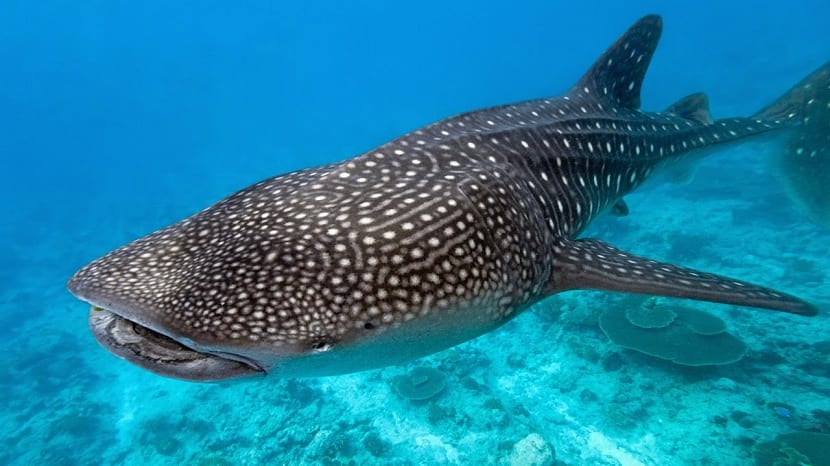
The world of sharks is completely exciting. They are considered the ocean's predators par excellence. Some sharks are better known and feared than others, such as the white sharkoo the bull shark, for its enormous ferocity. Today we talk about whale shark. It is a species of orectolobiform elasmobranch that belongs to the Rhincodontidae family. Its scientific name is Rhincodon typus and it is considered the largest fish in the world.
Do you want to know more about the whale shark? Here we tell you everything about its characteristics and way of life.
Key features
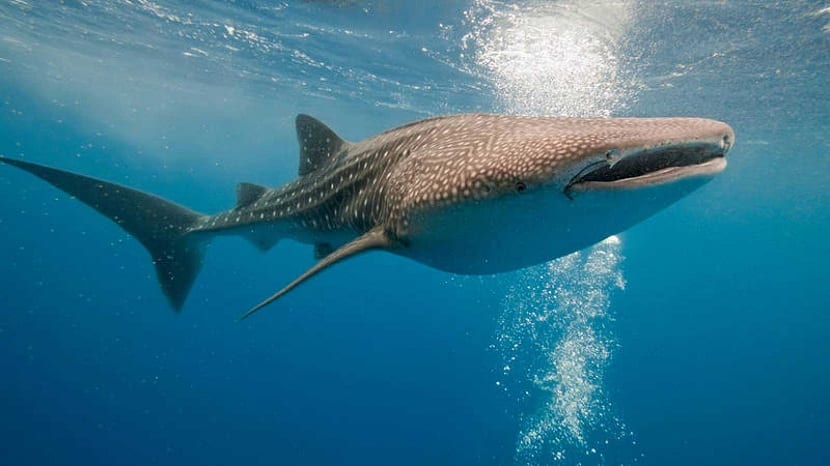
In nature there are times when a common name of some species is due to its resemblance to another animal or object. We find some species like the crocodile fish and ax fish, both named for their resemblance to the crocodile and a saw, respectively. Well then, the whale shark owes its name to its resemblance to this huge mammal. Not only because of its size, but because of its characteristics and morphology.
It has a colossal size of 12 meters in length. It lives in tropical and subtropical waters. Although it is not known for sure, it is thought that has lived on our planet for 60 million years, so it is a species that has adapted to different environments and has evolved a lot.
The belly of these sharks is totally white, just like that of a whale. It has a grayish back. It is darker than most sharks and has a multitude of white or yellowish spots and horizontal and vertical lines. There are people who resemble this type of morphology and details to a chessboard. In some places it is also known as a chess fish, although this name is much less used. It is easy to census whale shark populations given that they are unmistakable due to their size and design.
It can be up to 10 centimeters thick on the skin. The body has hydrodynamic characteristics and its head is wide and flattened. The sides have small eyes in which they have spiracles. It has a large mouth to swallow its prey with great ease. It can measure 1,5 meters open. This allows the whale shark to swallow a seal by swimming sideways and has a multitude of teeth arranged in rows.
Whale shark habitat
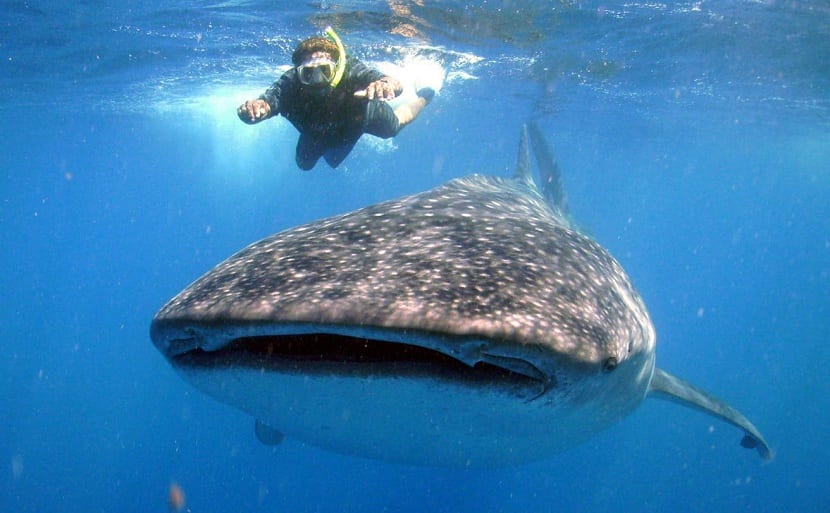
This shark inhabits the waters of the warmer oceans. It is always distributed near the tropics. According to some studies, they are thought to be pelagic fish, so they spend almost the maximum time of their life on the surface. At some times of the year they migrate to coastal areas where they can be warned.
It has been seen in areas such as Ningaloo Reef in Western Australia, Batangas in the Philippines, Utila in Honduras, in the Yucatan and the Pemba and Zanzibar islands of Tanzania. It is common to find it offshore, but also on the coast as well as coral atolls and near some river mouths and their estuaries.
It is said that it is not a species that inhabits the depths because it is usually kept at a maximum depth of 700 meters. In a matter of latitude, it stays between 30 and -30 degrees. It tends to have a solitary life, although it is found on some occasions forming groups to feed in larger areas with more food.
Among these sharks, males are more likely to travel between different sites, while females are more still. They are usually found in more specific places and the males in more disparate places.
Food
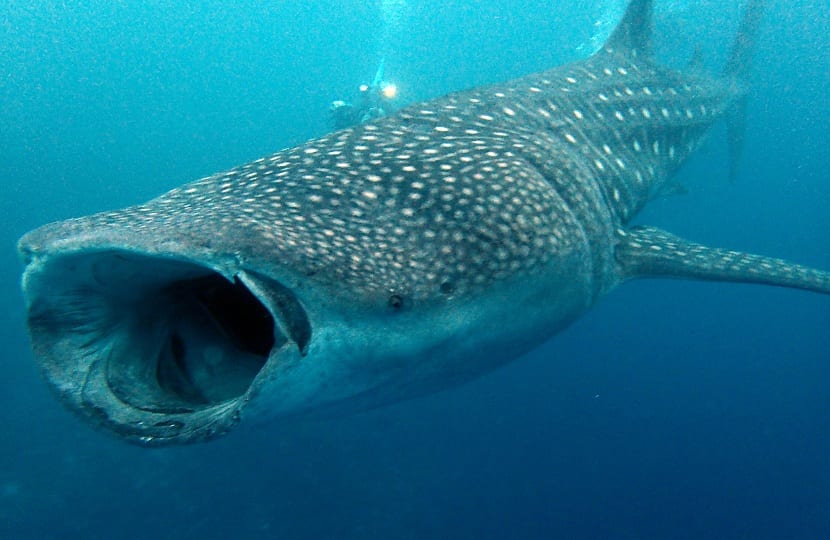
Another reason it is called a whale shark is because of the way it feeds. Despite what you may think when hearing the name of shark, it is not dangerous for humans at all. When we talk about sharks, the first thing you think of is that they are species that would tear us apart and split us in two as soon as we saw each other. Quite the opposite, it does not pose any threat to humans.
And this is because they feed through a water filtration mechanism, just like whales. There are two other species of shark that can do this, such as the broadmouth shark and the basking shark. They feed mainly on algae, krill, phytoplankton and nekton that are present in the water.
Since other species are found browsing the water, you cannot always be selective when filtering the water. For this reason, it also feeds on some crustaceans such as crab larvae, from small schools de peces, sardines, mackerel, tuna and squid.
As we have mentioned before, the teeth that it has are small, since they do not need them for almost anything. What it does to feed itself is to suck a large amount of water and when it closes its mouth, It filters the food with its gill combs and expels the water empty of food.
In their behavior with humans it can be said that they are very affectionate and playful with divers. There are some reports confirming that there are some whale sharks that come to the surface for divers to scratch their belly and remove some parasites. Swimmers and divers can calmly swim alongside this shark without any fear. You can take an unintended blow by wagging your tail.
Reproduction
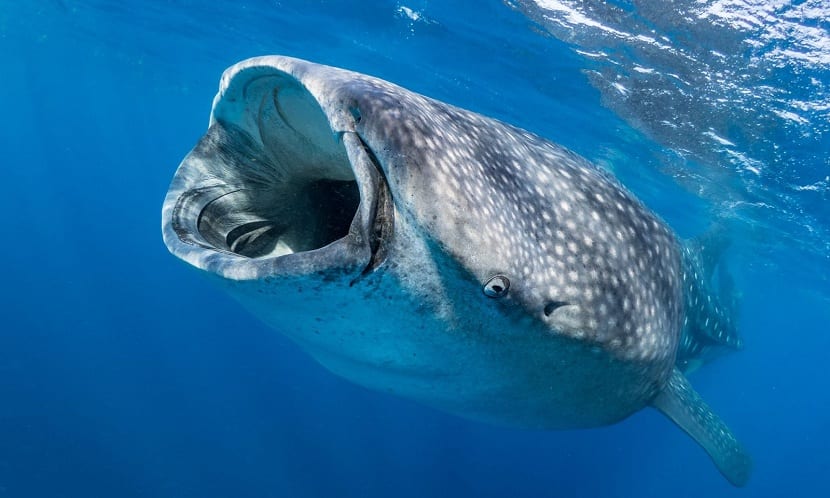
Although it has been difficult to know what its mode of reproduction was, after several studies from 1910 to 1996, it was learned that females are ovoviviparous. The young hatch from the egg inside their mother. When they have finished developing, the mother gives birth to them alive. They are very small newborns. They only measure between 40 and 60 cm in length.
Not much is known about the young specimens as they are barely visible. There are also no morphometric reports to know more about its development and to know its growth rate. They are thought to be sexually mature in their 30s and their lives can last up to 100 years.
I hope this information helps you to know more about the whale shark.